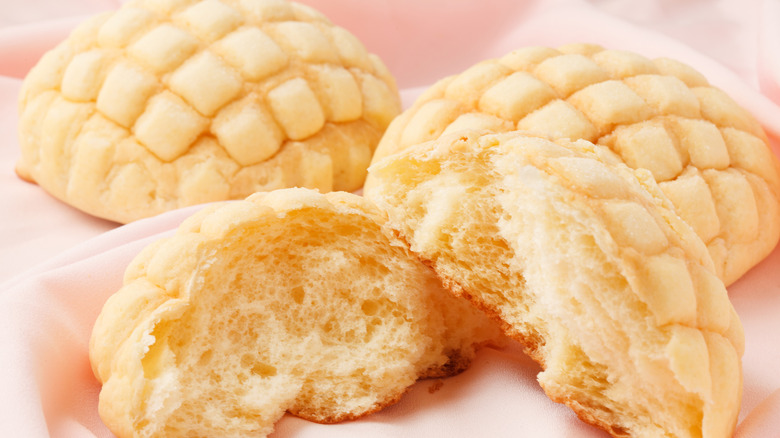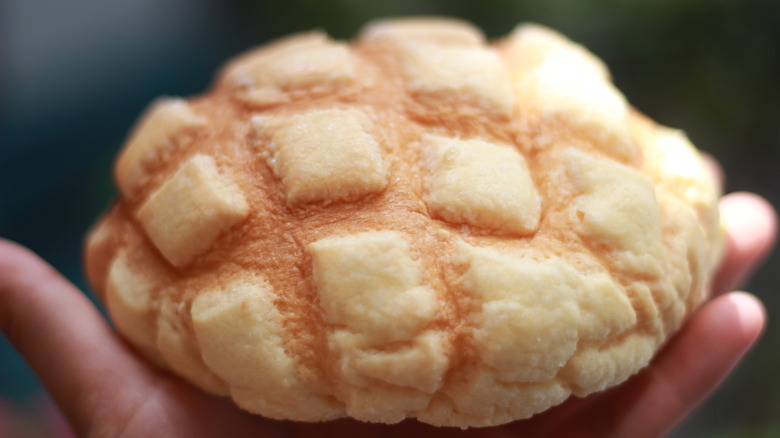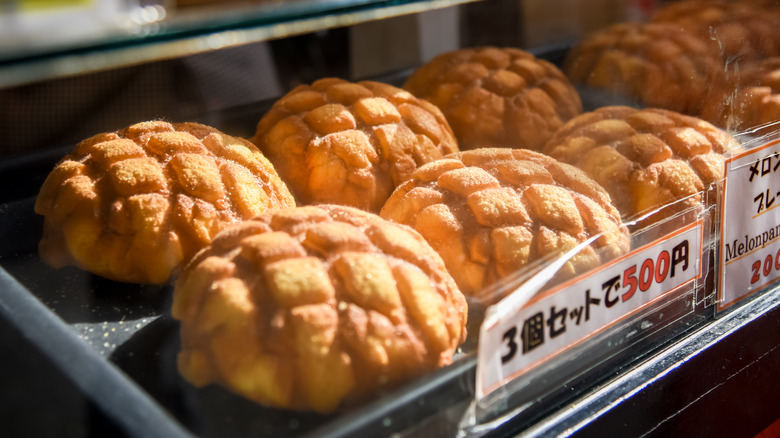What Exactly Is Melon Bread And What Does It Taste Like?
Japan has the cultural market cornered when it comes to eating on the go. There are many Japanese convenience store foods that we wish we had in America, like bento boxes, onigiri, and seriously good instant ramen, and Japanese bakeries are a wonderland for anyone with an adventurous sweet tooth. The selection on offer may look familiar at first sight, including colorful slices of cakes, various single-serving soft buns, and delicate pastries filled with impossibly fluffy cream. However, on closer inspection, the flavors may not be what you are used to enjoying in a sweet application. Matcha, red bean, and even curry get their moment in the land of the rising sun. One bakery offering is particularly popular, dubbed "melon pan" or "melon bread."
Melon bread has two distinct layers — a crunchy top layer and a soft, almost squishy base layer. Is any part of it melon-flavored? Contrary to its name, it is not, at least not by default. Melon bread gets its name from its craggy, biscuit-like surface which resembles the skin of cantaloupes, known as rockmelon or muskmelon in other parts of the world. Flavor-wise, it has a neutral sweet sugary taste from its crunchy topping, with a hint of milk from the soft bun base. That said, many melon breads come in additional flavors like chocolate, strawberry, and yes, matcha.
Possible origins of melon bread
One possible origin for melon bread dates back to the early 1900s when it was rumored that a Japanese businessman brought an Armenian baker to Japan, and this baker created the original melon pan to resemble a French galette (likely the celebratory version called galette des rois if looks are anything to go by). Even though that story may not be confirmed, what is true is that there are other, similarly structured sweet buns prevalent in different parts of the world. In nearby Hong Kong, the bolo bao, or "pineapple bun" is made in a similar way — unsurprisingly, not containing any pineapple either. Eagle-eyed folks would recognize its visual similarity to Mexican conchas, which some say came via French immigrants in 19th century Mexico. The trail leads from there to Asia, where Chinese-Mexicans returned to in the early 20th century, which coincides with the timing of the Armenian baker story.
While its origin story is convoluted, traversing continents and centuries, there is no doubt that these different buns are at least visually and texturally similar. Now in the 21st century, melon breads, along with its cousins, are still enjoyed as portable sweet snacks in different parts of the world.
Achieving the texture of melon bread
Let's talk a little bit more about the construction of melon bread. If you have ever made Mexican conchas or even a St. Louis gooey butter cake, the process is very similar. The bread is made in two parts, with the bottom layer made out of a soft, yeasted dough, while the top layer is where much of the sugar resides. When baked together, the two layers meld, though maintaining their separate textures, and the top layer turns into a crackly, biscuity topping much like a streusel but much more adherent.
There are subtle differences in the textures and flavors between melon bread and its counterparts, as well. The soft base is said to be firmer than a pineapple bun's, though softer than a concha. The topping of melon bread however tends to be much crispier than other similar treats, giving a pleasant textural contrast. Even if for that sweet and addictively crunchy topping alone, melon pan deserves a place on the to-eat list of any traveler venturing to Japan.


